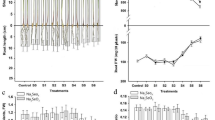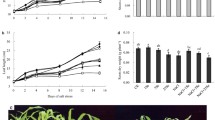Abstract
The study was conducted in order to determine the effects of exogenous selenium (Se) supply (5, 10, or 20 μM) on the resistance of cucumber (Cucumis sativus L.) cv. Polan F1 seedlings to salt stress (50 mM NaCl). Plant growth was negatively affected by excessive salinity and dry mass production as well as photosynthetic pigments accumulation severely decreased. Se treatments at 5 and 10 μM significantly improved the growth rate and increased the photosynthetic pigments and proline contents in cucumber leaves subjected to salt stress. Moreover, it is concluded that Se enhanced the salt tolerance of seedlings by protecting the cell membrane against lipid peroxidation. The growth-promoting effect of low Se concentrations (5 and 10 μM) under saline conditions could be due to the antioxidative activity of Se, increase in proline accumulation and/or decrease in content of chloride ions in the shoots tissues. Thus, optimal Se supplementation presents a promising potential for use in conditions of relatively high levels of NaCl in the medium.



Similar content being viewed by others
Abbreviations
- AAS:
-
Atomic absorption spectrometry
- DW:
-
Dry weight
- FW:
-
Fresh weight
- MDA:
-
Malondialdehyde
- TBA:
-
Thiobarbituric acid
- TCA:
-
Trichloroacetic acid
References
Zhu JK (2001) Plant salt tolerance. Trends Plant Sci 6:66–71
Luo Q, Yu B, Liu Y (2005) Differential sensitivity to chloride and sodium ions in seedlings of Glycine max and G. soja under NaCl stress. J Plant Physiol 162:1003–1012
Hussain TM, Chandrasekhar T, Hazara M, Sultan Z, Saleh BK, Gopal GR (2008) Recent advances in salt stress biology—a review. Biotech Mol Biol Rev 3(1):8–13
Sairam RK, Tyagi A (2004) Physiology and molecular biology of salinity stress tolerance in plants. Curr Sci 86:407–421
Kong L, Wang M, Bi D (2005) Selenium modulates the activities of antioxidant enzymes, osmotic homeostasis and promotes the growth of sorrel seedlings under salt stress. Plant Growth Reg 45:155–163
Kaja C, Higgs D (2002) Calcium nitrate as a remedy for salt-stressed cucumber plants. J Plant Nutr 25:861–871
Tuna AL, Kaya C, Ashraf M, Altunlu H, Yokas I, Yagmur B (2007) The effects of calcium sulphate on growth, membrane stability and nutrient uptake of tomato plants grown under salt stress. Environ Exp Bot 59(2):173–178
Elkhatib HA, Elkhatib EA, Allah AMK, El-Sharkawy AM (2004) Yield response of salt stressed potato to potassium fertilization: a preliminary mathematical model. J Plant Nutr 27:111–122
Kaja C, Higgs D, Sakar E (2002) Response of two leafy vegetables grown at high salinity to supplementary potassium and phosphorus during different growth stages. J Plant Nutr 25:2663–2676
Rayman MP (2000) The importance of selenium to human health. Lancet 356:233–241
Terry N, Zayed AM, De Souza MP, Tarun AS (2000) Selenium in higher plants. Ann Rev Plant Physiol Plant Mol Biol 51:401–432
Xue T, Hartikainen H, Piironen V (2001) Antioxidative and growth-promoting effect of selenium on senescing lettuce. Plant Soil 237(1):55–61
Djanaguiraman M, Devi DD, Shanker AK, Sheeba JA, Bangarusamy U (2005) Selenium—an antioxidative protectant in soybean during senescence. Plant Soil 272(1–2):77–86
Turakainen M, Hartikainen H, Seppänen MM (2004) Effects of selenium treatments on potato (Solanum tuberosum L.) growth and concentrations of soluble sugars and starch. J Agric Food Chem 52:5378–5382
VasV K, Kholodova VP, VlV K, Yagodin BA (2003) Selenium regulates the water status of plants exposed to drought. Dokl Biol Sci 390:266–268
Germ M, Kreft I, Stibilj V, Urbanc-Berčič O (2007) Combined effects of selenium and drought on photosynthesis and mitochondrial respiration in potato. Plant Physiol Biochem 45(2):162–167
Yao X, Chu J, Wang G (2009) Effects of selenium on wheat seedlings under drought stress. Biol Trace Elem Res (in press). doi: 10.1007/s12011-009-8328-7
Hartikainen H, Xue T (1999) The promotive effect of selenium on plant growth as trigged by ultraviolet irradiation. J Environ Qual 28:1272–1275
Valkama E, Kivimäenpää M, Hartikainen H, Wulff A (2003) The combined effects of enhanced UV-B radiation and selenium on the growth, chlorophyll fluorescence and ultrastructure in strawberry (Fragaria x ananassa) and barley (Hordeum vulgare) treated in the field. Agric Forest Met 120:267–278
Fargašová A, Pastierová J, Svetková K (2006) Effect of Se-metal pair combinations (Cd, Zn, Cu, Pb) on photosynthetic pigments production and metal accumulation in Sinapis alba L. seedlings. Plant Soil Environ 52(1):8–15
Hawrylak B, Matraszek R, Szymańska M (2007) Reaction of lettuce (Lactuca sativa L.) to selenium in nutrient solution contaminated with nickel. Veg Crops Res Bull 67:63–70
Filek M, Keskinen R, Hartikainen H, Szarejko I, Janiak A, Miszalski Z, Golda A (2008) The protective role of selenium in rape seedlings subjected to cadmium stress. J Plant Physiol 165(8):833–844
Ríos JJ, Blasco B, Cervilla LM, Rosales MA, Sanchez-Rodriguez E, Romero L, Ruiz JM (2008) Production and detoxification of H2O2 in lettuce plants exposed to selenium. Ann Appl Biol 154:107–116
Mc Neilly T (1994) Metal toxicity. In: Yeo AR, Flowers TJ (eds) Soil mineral stresses. Approaches to crop improvement. Springer, Berlin, pp 145–174
Lichtenthaler HK, Wellburn AR (1983) Determination of total carotenoids and chlorophyll a and b of leaf extracts in different solvents. Biochem Soc Trans 603:591–592
Bates L, Waldren R, Teare J (1973) Rapid determination of free proline for water stress studies. Plant Soil 39:205–207
Boominathan R, Doran PM (2002) Ni-induced oxidative stress in roots of the Ni hyperaccumulator, Alyssum bertolonii. New Phytol 156:205–215
Ostrowska A, Gawliński S, Szczubiałka Z (1991) Methods useful in analysis and estimation of soils and plants properties (in Polish: Metody analizy i oceny właściwości gleb i roślin). Katalog Instytutu Ochrony Środowiska, Warszawa
Al-Harbi AR (1994) Influence of salinity on the growth and nutrients composition of cucumber plants (Cucumis sativus). J King Saud Univ 6:263–271
Sultana N, Ikeda T, Itoh R (1999) Effect of NaCl salinity on photosynthesis and dry matter accumulation in developing rice grains. Environ Exp Bot 42(3):211–220
Khan NA (2003) NaCl inhibited chlorophyll synthesis and associated changes in ethylene evolution and antioxidative enzyme activities in wheat. Biol Plant 47(3):437–440
Jaleel CA, Sankar B, Sridharan R, Panneerselvam R (2008) Soil salinity alters growth, chlorophyll content, and secondary metabolite accumulation in Catharanthus roseus. Turk J Biol 32:79–83
Foyer CH, Lelandais ML, Kunert KJ (1994) Photooxidative stress in plants. Physiol Plant 92(4):696–717
Strzałka K, Kostecka-Gugała A, Latowski D (2003) Carotenoids and environmental stress in plants: significance of carotenoid-mediated modulation of membrane physical properties. Russ J Plant Physiol 50(2):168–173
Chen TF, Zheng WJ, Wong YS, Yang F (2008) Selenium-induced changes in activities of antioxidant enzymes and content of photosynthetic pigments in Spirulina platensis. J Integr Plant Biol 50(1):40–48
Hartikainen H, Xue T, Piironen V (2000) Selenium as an anti-oxidant and pro-oxidant in ryegrass. Plant Soil 225:193–200
Padmaja K, Prasad D, Prasad AR (1990) Selenium as a novel regulator of porphyrin biosynthesis in germinating seedlings of mung bean (Phaseolus vulgaris). Biochem Intern 22:441–446
Thakur M, Sharma AD (2005) Salt-stress-induced proline accumulation in germinating embryos: evidence suggesting a role of proline in seed germination. J Arid Environ 62(3):517–523
Zhu J, Bie Z, Li Y (2008) Physiological and growth responses of two different salt-sensitive cucumber cultivars to NaCl stress. Soil Sci Plant Nutr 54(3):400–407
Khedr AHA, Abbas MA, Wahid AAA, Quick WP, Abogadallah GM (2003) Proline induces the expression of salt-stress-responsive proteins and may improve the adaptation of Pancratium maritimum L. to salt-stress. J Exp Bot 54(392):2553–2562
Alpaslan M, Gunes A (2001) Interactive effects of boron and salinity stress on the growth, membrane permeability and mineral composition of tomato and cucumber plants. Plant Soil 236:123–128
Zheng Y, Jia A, Ning T, Xu J, Li Z, Jiang G (2008) Potassium nitrate application alleviates sodium chloride stress in winter wheat cultivars differing in salt tolerance. J Plant Physiol 165(14):1455–1465
Suárez N, Medina E (2008) Salinity effects on leaf ion composition and salt secretion rate in Avicennia germinans (L.) L. Braz J Plant Physiol 20(2):131–140
Wu L, Huang ZZ, Burau RG (1988) Selenium accumulation and selenium-salt cotolerance in five grass species. Crop Sci 28:517–522
Author information
Authors and Affiliations
Corresponding author
Rights and permissions
About this article
Cite this article
Hawrylak-Nowak, B. Beneficial Effects of Exogenous Selenium in Cucumber Seedlings Subjected to Salt Stress. Biol Trace Elem Res 132, 259–269 (2009). https://doi.org/10.1007/s12011-009-8402-1
Received:
Accepted:
Published:
Issue Date:
DOI: https://doi.org/10.1007/s12011-009-8402-1




